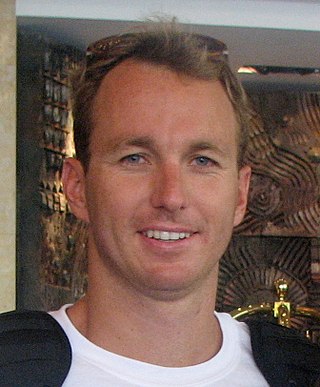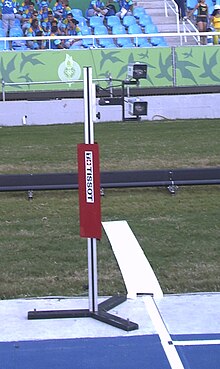
Robert Lee Hayes, nicknamed "Bullet Bob", was an American sprinter and professional football player. After winning gold medals at the 1964 Summer Olympics, he played as a split end in the National Football League (NFL) for the Dallas Cowboys. Hayes is the only athlete to win both an Olympic gold medal and a Super Bowl ring. He was a two-sport stand-out in college in both track and field and football at Florida A&M University. Hayes was enshrined in the Dallas Cowboys Ring of Honor in 2001 and was selected for induction in the Pro Football Hall of Fame in January 2009. Hayes is the second Olympic gold medalist to be inducted to the Pro Football Hall of Fame, after Jim Thorpe. He once held the world record for the 70-yard dash. He also is tied for the world's second-fastest time in the 60-yard dash. He was once considered the "world's fastest human" by virtue of his multiple world records in the 60-yard, 100-yard, 220-yard, and Olympic 100-meter dashes. He was inducted into the United States Olympic Hall of Fame.

Aaron Wells Peirsol is an American former competition swimmer and backstroke specialist who is a former world champion and world record-holder. He is a three-time Olympian and seven-time Olympic medalist. Individually, he currently holds the world record in the 200-meter backstroke event. In February 2011, Peirsol announced his retirement, saying, "I ended up doing everything I set out to do."

A stopwatch is a timepiece designed to measure the amount of time that elapses between its activation and deactivation.

When setting photoflash exposures, the guide number (GN) of photoflash devices is a measure photographers can use to calculate either the required f‑stop for any given flash-to-subject distance, or the required distance for any given f‑stop. To solve for either of these two variables, one merely divides a device's guide number by the other.

A photo finish occurs in a sporting race when multiple competitors cross the finishing line at nearly the same time. As the naked eye may not be able to determine which of the competitors crossed the line first, a photo or video taken at the finish line may be used for a more accurate check. Photo finishes make it less likely that officials will declare a race a dead heat.
The 40-yard dash is a sprint covering 40 yards (36.576 m). It is primarily run to evaluate the speed and acceleration of American football players by scouts, particularly for the NFL Draft but also for collegiate recruiting. A player's recorded time can have a heavy impact on his prospects in college or professional football. This was traditionally only true for the "skill" positions such as running back, wide receiver, and defensive back, although now a fast 40-yard dash time is considered important for almost every position. The 40-yard dash is not an official race in track and field athletics, and is not an IAAF-recognized race.

Kaio Márcio Ferreira Costa de Almeida is a Brazilian swimmer who specializes in the butterfly. He is also known by the reduced versions of his name: Kaio Márcio, Kaio Márcio de Almeida, Kaio Almeida, or Kaio de Almeida.
The men's 100 metres was the shortest of the men's track races in the Athletics at the 1964 Summer Olympics program in Tokyo, Japan. It was held at the Olympic Stadium on 14 and 15 October 1964. 76 athletes from 49 nations entered, with 3 not starting in the first round. Nations were limited to three athletes each, per rules in force since the 1930 Olympic Congress. The first two rounds were held on 14 October, with the semifinals and the final on the following day.

Nathan Ghar-jun Adrian is an American competitive swimmer and five-time Olympic gold medalist who formerly held the American record in the long course 50-meter freestyle event.

Matthew Grevers is an American competition swimmer who competes in the backstroke and freestyle events, and is a six-time Olympic medalist. He has won a total of thirty-three medals in major international competition, fourteen gold, twelve silver, and seven bronze spanning the Olympics, World Championships, and the Universiade. At the 2008 Summer Olympics, Grevers won gold medals as a member of the U.S. teams in the 4×100-meter freestyle and 4×100-meter medley relays, and a silver medal in the 100-meter backstroke. Four years later, at the 2012 Summer Olympics, he won gold medals in the 100-meter backstroke and the 4×100-meter medley relay, and a silver medal in the 4×100-meter freestyle relay.

Michael Fred Phelps II is an American former competitive swimmer. He is the most successful and most decorated Olympian of all time with a total of 28 medals. Phelps also holds the all-time records for Olympic gold medals (23), Olympic gold medals in individual events (13), and Olympic medals in individual events (16). At the 2004 Summer Olympics in Athens, Phelps tied the record of eight medals of any color at a single Games, held by gymnast Alexander Dityatin, by winning six gold and two bronze medals. Four years later, when he won eight gold medals at the 2008 Beijing Games, he broke fellow American swimmer Mark Spitz's 1972 record of seven first-place finishes at any single Olympic Games. At the 2012 Summer Olympics in London, Phelps won four gold and two silver medals, and at the 2016 Summer Olympics in Rio de Janeiro, he won five gold medals and one silver. This made him the most successful athlete of the Games for the fourth Olympics in a row.
The 10-second barrier is the physical and psychological barrier of completing the 100 metres sprint in under ten seconds. The achievement is traditionally regarded as the hallmark of a world-class male sprinter. Its significance has become less important since the late 1990s, as an increasing number of runners have surpassed the ten seconds mark. The current men's world record holder is Usain Bolt, who ran a 9.58 at the 2009 IAAF World Championship competition.

Guilherme Augusto Guido is a Brazilian backstroke swimmer who specializes in sprint events. He was twice a finalist in the 100 metre backstroke at World Championships

Thomas Allen Shields is an American competitive swimmer. He is a two-time Olympian and the current American record-holder in the short course 50-meter butterfly and 200-meter butterfly. At the 2016 Summer Olympics, he won a gold medal in the 4×100-meter medley relay, swimming the butterfly leg of the relay in the prelims. Later the same year, he became the first American to swim faster than 44 seconds in the 100-yard butterfly, setting a new American record of 43.84 seconds.

Florent Manaudou is a French competitive swimmer, an Olympic champion of the 50-meter freestyle at the 2012 London Olympics, and the younger brother of Laure Manaudou, a 2004 Olympic gold medalist in swimming. He competes for the Energy Standard Swim Club in the International Swimming League.
Kieran Smith is an American swimmer specializing in freestyle and individual medley events. He currently co-holds short course world records in the 4×200 meter freestyle relay and the 4×100 meter medley relay. He is the Americas record holder in the long course 400 meter freestyle and the American record holder in the 500 yard freestyle. In the 400 meter freestyle, he won the bronze medal at the 2020 Summer Olympics and the gold medal at the 2022 World Short Course Championships. Following a fourth-place finish in the 4×200 meter freestyle relay at the 2020 Summer Olympics, he won gold medals in the event at the 2021 World Short Course Championships, 2022 World Aquatics Championships, and the 2022 World Short Course Championships.
Drew Kibler is an American competition swimmer specializing in freestyle events. He is a world record holder in the short course 4×200 meter freestyle relay and a former American record holder in the 4×200 yard freestyle relay. He won a gold medal in the 4×200 meter freestyle relay each at the 2022 World Aquatics Championships and the 2022 World Short Course Championships and placed fourth in the event at the 2020 Summer Olympics. In the 200 meter freestyle, he took fourth-place at both the 2022 World Aquatics Championships and the 2022 World Short Course Championships. He is also a three-time NCAA champion in the 4×200 yard freestyle relay, winning NCAA titles in the event in 2019, 2021, and 2022.

Joseph Hunter Armstrong is an American swimmer. He is the world record holder in the long course 50 meter backstroke. At the 2022 World Aquatics Championships, he won a silver medal in the 50 meter backstroke, a bronze medal in the 100 meter backstroke, gold medals in the 4×100 meter freestyle relay and 4×100 meter mixed medley relay, and a silver medal in the 4×100 meter medley relay. At the 2020 Summer Olympics, he won a gold medal in the 4×100 meter medley relay, swimming backstroke in the preliminaries, and placed ninth in the 100 meter backstroke.
Shaine Casas is an American professional swimmer. He is an Americas record holder in the short course 4×50 meter medley relay, swimming the butterfly leg of the relay. At the 2021 World Short Course Championships, he won the gold medal in the 100-meter backstroke, a silver medal in the 200-meter backstroke, and placed seventh in the 50-meter backstroke. In 2022, at the year's World Aquatics Championships, he won the bronze medal in the 200-metre backstroke. Later in the year, at the 2022 World Short Course Championships, he won the silver medal in the 200-metre backstroke and placed fourth in the finals of the 100-meter individual medley and 200-meter individual medley.
Trenton Jeffrey Julian is an American competitive swimmer. He is a world record holder in the short course 4×200 meter freestyle relay and 4×100 meter medley relay. He won a gold medal in the 4×200 meter freestyle relay at the 2019 World University Games. He followed up with gold medals in the 4×200 meter freestyle relay at the 2021 World Short Course Championships, 2022 World Aquatic Championships, and 2022 World Short Course Championships. In the 4×100 meter medley relay, he won a world title and gold medal at the 2022 World Short Course Championships, swimming butterfly on each the prelims and finals relay.

















